| Following the European regulations on data protection (GDPR), we inform you that we use cookies to guarantee you the best experience on this website, to personalize the advertisements (which allow the free use of this site) and to analyze the site traffic. If this message appears all the time when opening pages, click on "Find out more". By continuing to browse our site, you accept the use of these cookies which allow us to compile visit statistics and personalize advertising inserts. Close Learn more. How to Solve Sudoku Puzzle |
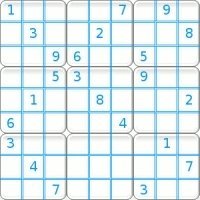 | 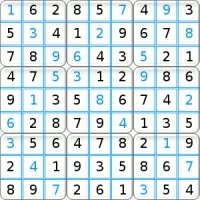 |
| A sudoku puzzle | The solution |
A "row" is a horizontal line of nine squares.
A "column" is a vertical line of nine squares.
A "region" is a block of 3 x 3 squares.
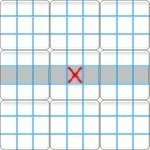 | 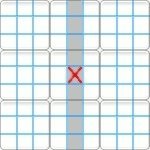 | 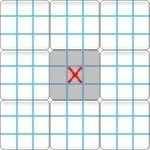 |
| Row | Column | Region |
A "group" refers to either a row, column or region.
Each square belongs to three different groups. For example, the central square belongs to the following three groups:
 | In summary, the three different groups of a square are subject to the same constraints: They each contain the numbers from 1 to 9 which cannot be used more than once. |
| Three groups |
Solution methods.
The following basic methods for solving puzzles are listed below. Other methods shall be added as the software is updated.
There are two principle solution methods.
• Those puzzles which can be solved directly by using a visual diagram.
• Those puzzles which can be solved specifically by candidate highlighting.
Candidates of a square refer to the possible numbers that can be entered into that particular square. All of the candidates of a Sudoku puzzle include all the possibilities for all the squares of a grid. The site allows you to display them at any time.
It is advisable, in order to make it easier to solve the puzzle, to start by solving the maximum number of squares visually in order to finish with the minimum number of candidates to be written.
The four basic methods:
Method by inclusion
• Visually or by reading candidates
Method by exclusion
• Visually or by reading candidates
Method by exclusive pairs
• By reading candidates
Multiple choice
• By reading candidates
Method by Inclusion
One square accepts a number if the three groups of this square have already included eight different numbers. Solutions for this method are those using visual approaches or by studying highlighted candidates.
Visual approach:
Example: The three groups of the purple square L4C9, already include the eight numbers, in green: 7,2,3,4,6,1,5 and 9. Therefore, 8 is the only solution for this square.
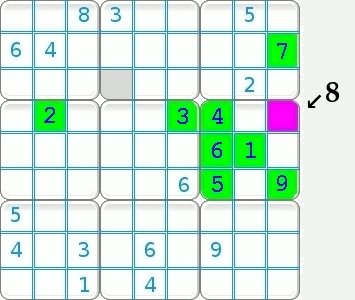
There is no specific visual approach to be applied. Attention should be paid to the squares which have the greatest amount of numbers within them. For example, the gray square L3C4 doesn't prove to be of any interest because there are only two numbers relative to it.
In this grid, a second square uses a solution by inclusion. Can you find it?
Reading the highlighted candidates:
A square having only one possibility naturally uses this possibility as its solution. The purple square L4C9 has only one candidate thereby confirming the visual approach used above.
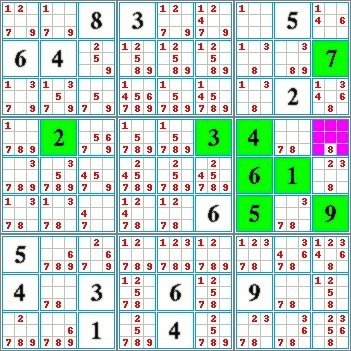
Have you found the second square?!
In order to practice using this technique, all the beginner level grids found on this site can be solved using the inclusion method.
Method by exclusion
One square accepts a number if this number is excluded from all the other squares of a group pertaining to this particular square. You will notice that a square accepting a solution by exclusion normally has several different possible candidates. Otherwise this square is chosen more simply by inclusion.
This method is solved visually or by studying highlighted candidates.
Three types of cases are possible:
• Method by exclusion in a region
• Method by exclusion in a row
• Method by exclusion in a column
In order to practice using this technique, all the confirmed level puzzles found on this site can be solved using the inclusion and exclusion methods.
Method by exclusion in a region
Confirmed Level Grid N° 7218: | 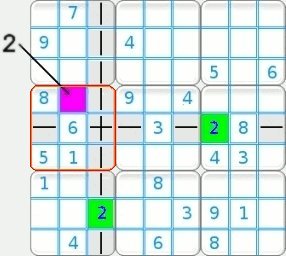 |
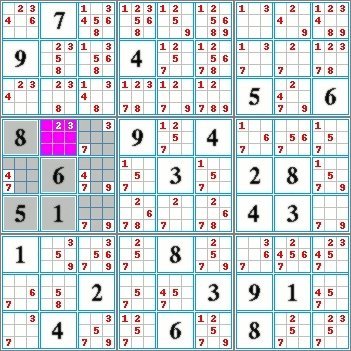 | Confirmed Level Grid n° 7218: |
In this puzzle, a second square accepts a solution by inclusion. Can you find it? The solution is shown below.
Method by exclusion in a column
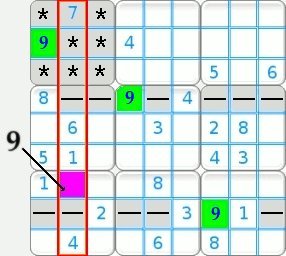 | Confirmed Level Grid N° 7218: |
Confirmed Level Grid N° 7218: | 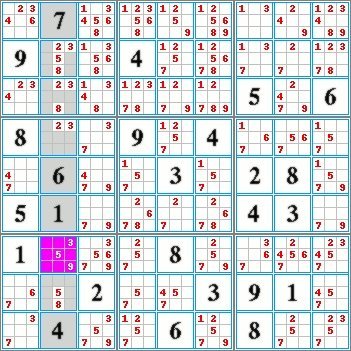 |
Method by exclusion in a row
 | Expert Level Grid N° 10000: |
Expert Level Grid N° 10000: | 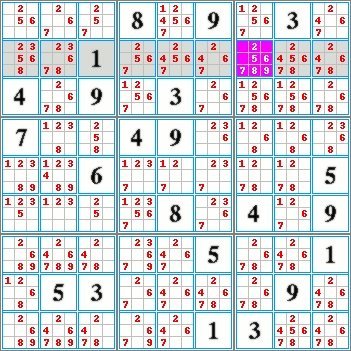 |
Method by exclusive pairs
This method requires the observation of all the highlighted candidates in the grid and involves two guesses.
1st condition: In a group, if two squares contain the same pair of numbers therefore these numbers can be excluded from other squares in this group.
2nd condition: If, following a result of this exclusion, one square is found to have one possible candidate only, then this candidate is the solution for the square.
Two types are possible.
• Exclusion of a number.
• Exclusion of two numbers.
Exclusive pair with one number
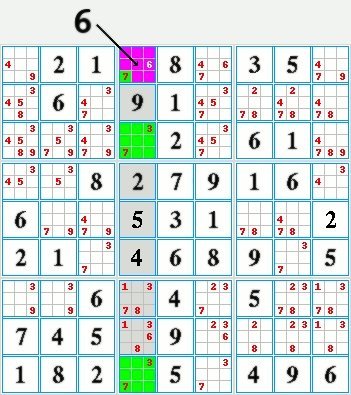 | Expert Level Grid N° 2616 in the process of being solved. |
Exclusive pair with two numbers
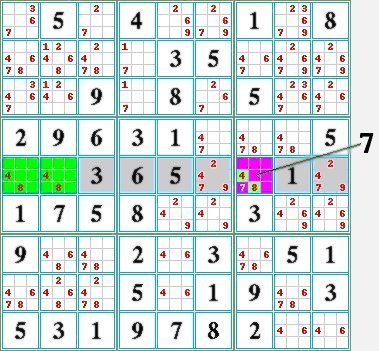 | Expert Level Grid N° 8131 in the process of being solved. |
Multiple Choice
Multiple choice is not, strictly speaking, a method for solving a square but moreover a lifeline for use as a last resort.
If no square has any solution we choose the one of the square having the least amount of possibilities. We try at random using one of the candidates from this square and attempt to solve the rest of the grid. If we come to a dead end, we retrace our steps backwards to square one having the multiple choice and start over again using another candidate.
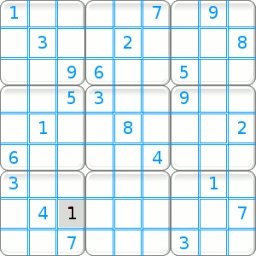 | The example shown to the left is a puzzle entitled "Al Escargot". To this day it is known as the most difficult Sudoku puzzle to solve. |
It appears as though there is no method which can be used for solving the squares for this problem. | 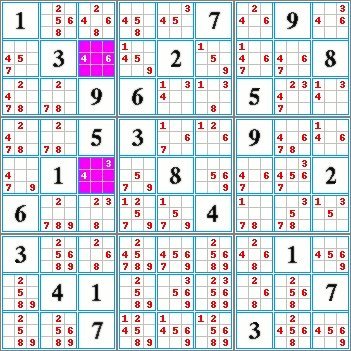 |
Solution methods not yet exploited by the site
The x-exclusives. Includes all those like exclusive pairs, triplets, quadruple exclusives etc...
Crossed solutions or solutions called level "x".
A pair or one x-exclusive can delete some of the candidates in a square "a" without actually solving it. That may, however, result in solving another square "b" connected with square "a" previously simplified...